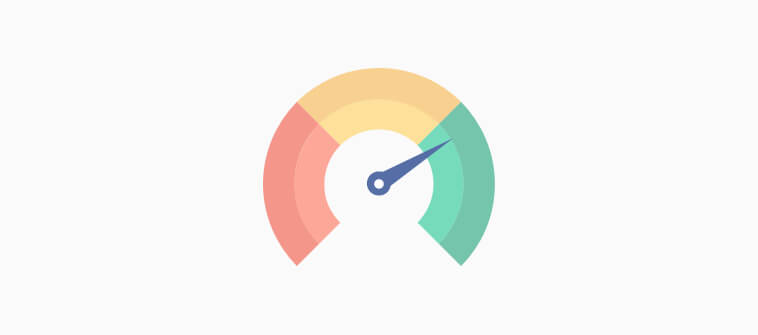
Customer effort score is based on the notion that the easier you make it for your customers to do business with you, the more likely they will return.
Of course, everyone likes to purchase from a brand where the buying process is easy, and you do not have to make a lot of effort to get something done.
In fact, a study by Gartner shows,
“96% of customers with a high-effort service interaction become more disloyal compared to just 9% who have a low-effort experience.”
In a nutshell, you can drive customer loyalty by reducing their efforts to interact with your business. Let’s discuss in detail what customer effort score is, its importance, examples, how, and when to calculate it.
What Is Customer Effort Score?
Customer Effort Score (CES) is a powerful metric to measure customer satisfaction levels. With the help of CES, you can assess how much effort a customer has to put in to interact with your company. Customer interactions can range from buying products and services, creating an account, subscribing to a demo or newsletter to resolving an issue with customer support. The fewer efforts customers have to put in, the more happy and satisfied they are and vice versa.
A customer effort score is measured with the help of a CES survey. This single-item survey asks customers how easy it is for them to interact with your business. It can be done by rating their agreement or disagreement level with a statement or rating their effort levels.
Keeping track of the customer experience score over time will enable organizations to determine the customer’s pain points and offer immediate resolutions to boost customer satisfaction.
Example of Customer Effort Score
CES, initially developed by the Corporate Executive Board as a better alternative to NPS, using a cross-sectional research approach, is gaining popularity these days as businesses strive to achieve customer satisfaction.
Let us understand how you can use customer effort score questions to determine customer satisfaction with the help of an example.
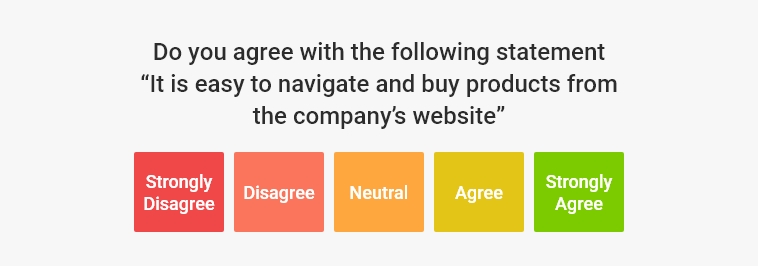
This question’s example uses the Likert 5-point scale to determine the ease of purchasing products from the website. Customers can select their rating, and you can have a quantitative data set that showcases the user experience and customer satisfaction for your product.
A high customer effort score indicates that customers find it easy to purchase from your website without any hassles. On the other hand, a low CES means that your customers go through tedious experiences to buy your products and services and might lead to high churn rates.
When to Use Customer Effort Score?
CES metric offers actionable insights into customer efforts at all stages of their journey. But it is essential to use the customer effort score at the right time for gathering effective responses. You can use CES at various touchpoints in the customer’s journey; the most popular uses cases include:
1. After the Purchase
One of the best times to send the CES survey is after the client has made a purchase or performed a transaction with your brand. It will help you get instant feedback about the ease of buying from your business from the customer’s point of view and what improvements need to be made to streamline the buying process. It can be:
- After booking an appointment
- After booking a demo
- Following a trial signup
- After an online purchase
- Following a subscription, etc.
For example, you can share a CES survey when the customer completes their online purchase. It will help you analyze how the customer’s purchasing experience was, if they faced any issues during the process and if any changes need to be made so that more people buy from you.
2. After the Service-Interaction
Another effective way of using the CES score is after a customer service touchpoint, that is, interaction with your customer service team. It can be in the form of raising tickets, communicating through email, or speaking on a call. It helps you determine how efficient your customer service team is and if there is any scope for improvement or training to increase overall efficiency.
Even HubSpot recommends sharing the CES survey after closing a support ticket to determine how effective customer service was in solving the issue.
Consider this example: You can send a CES survey after the customer support team resolves a ticket raised by the customer. In this case, you can ask the customer about the ease of getting their problem solved. You can also use open-ended questions in this type of survey to understand customers’ feedback in their own words.
3. To Measure Overall Customer Efforts
Apart from using the customer effort score survey at the particular levels of the customer journey, you can also use it to gauge overall customer satisfaction and loyalty. CES can be used among different teams like product teams to improve the overall effort experience of the customers. CES Survey helps you identify and resolve the real bottlenecks in the customer experience itself.
For example, modern survey maker tools like ProProfs Survey Maker uses CES questions on a scale of 1-10, like “How likely are you to recommend ProProfs to your friends?” to determine the overall customer experience and customer loyalty. The higher the score you obtain, the more likely customers are satisfied with your company.
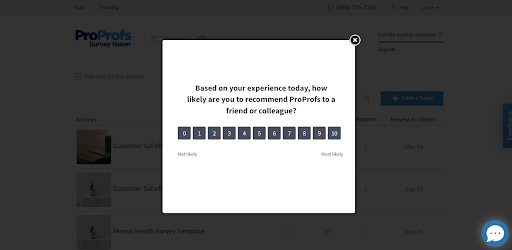
How to Calculate Customer Effort Score?
Customer effort score is calculated by conducting a survey and asking customers to gauge the ease of their experience. Customer effort score calculation depends on the type of survey and scales you employ. Let’s first discuss the type of CES surveys you can use to measure the customer effort score:
1. Likert Scale Survey
A Likert scale is an ordinal scale used to measure customer satisfaction. The scale options span from Strongly Agree to Strongly Disagree, allowing the survey maker to obtain a comprehensive picture of people’s opinions. All Likert scales feature a mid-point, which is (neutral) for individuals who neither agree nor disagree on the subject matter.
The 1-5 Scale
The 1-5 Likert scale is used when you need few answer choices as there is not much variation scope. In this type of scale, answer options are as follows:
- 1- Strongly Disagree
- 2- Disagree
- 3- Neutral
- 4- Agree
- 5-Strongly Agree
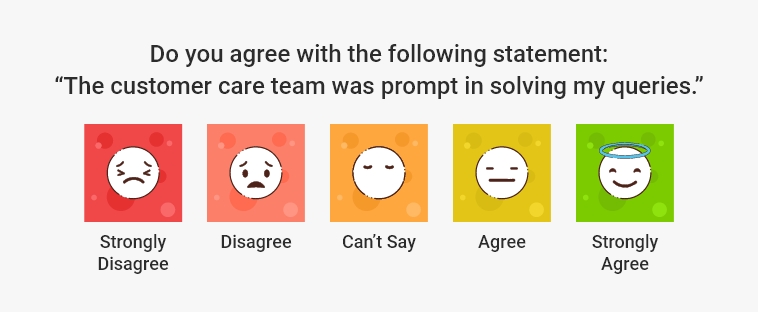
The 1-7 Scale
The 7-point scale adds two more answer choices at the furthest ends of a 5-point Likert scale question. The answer options in this type of scale are structured in the following way:
- 1-Strongly Disagree
- 2- Disagree
- 3- Somewhat Disagree
- 4- Can’t say
- 5- Somewhat Agree
- 6- Agree
- 7- Strongly Agree
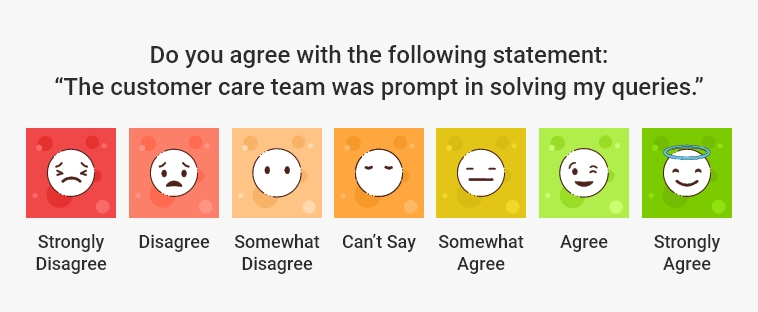
2. The 1-10 Scale Survey
The 1–10 scale involves numeric rating by customers that makes it easy to turn your raw data into a CES score. It entails asking respondents to answer your customer effort score question by rating on a scale of 1 to 10. Usually, the 7-10 segment is associated with positive responses if you ask customers how easy it was to do something.
However, if you ask the customers to rate how much effort they put in, the 1-3 range will be linked to promising results since they represent a low effort by customers.

3. Emotions Faces Survey
This type of survey is relatively short as it uses only three types of images as responses – a happy face, a neutral face, and an unhappy face. Here, a happy face as an answer response implies little effort was required from the customer’s side to interact with your brand. It makes it easy for respondents to answer this type of survey.
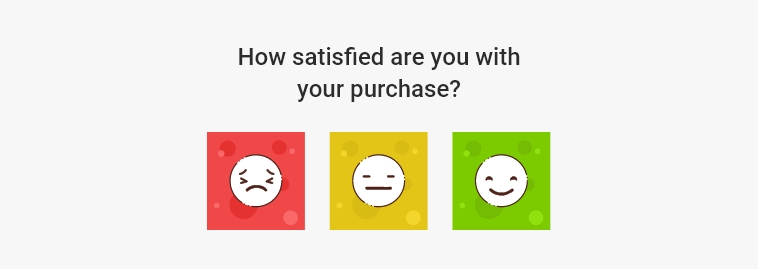
FREE. All Features. FOREVER!
Try our Forever FREE account with all premium features!
Formula for Calculating Customer Effort Score
CES is calculated by adding all the customer effort scores divided by the total number of responses.

Suppose you have six respondents rating their experience on a scale of 1-5, 1 being Highly Dissatisfied and 5 being Highly Satisfied.
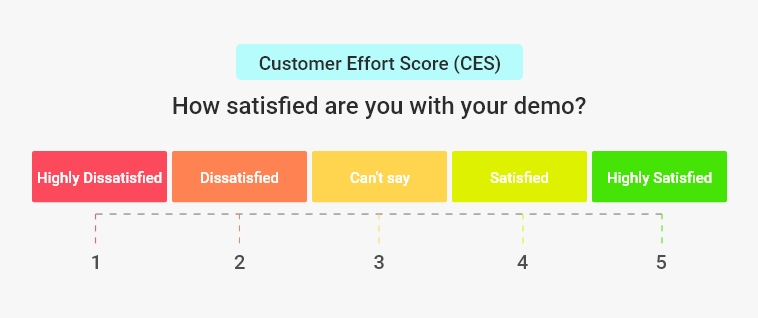
Suppose you receive the following scores from 6 respondents:
4,3,2,4,3,1
So, customer effort score calculation will be 4+3+2+4+3+1 / 6 = 2.83
Customer effort score = 2.83
For the emojis survey, calculate the percentage of both happy and sad faces out of the total number of respondents to calculate the customer effort score.
What Is a Good Customer Effort Score?
Customer effort score is different for every company and team. As per CEB Global, a Customer Effort Score above 2.0 is considered a good CES score. On the other hand, if the customer effort score is less than 2.0, you should look into why the customers aren’t happy and work on resolving the issues your customers are facing.
Let us now look at the current customer effort score benchmarks as per the industry standards.
CES Benchmarks
As discussed above, Gartner released the customer effort score benchmark, showing customer effort score percentages below 70% as areas for improvement and above 90% as strong CES scores.
While benchmarking CES, you should never forget that though it always looks enticing to look at the CES score of your competitors, it should not be your sole concern. Instead of comparing your effort scores with your competitors, comparing your current score with what it was six months or a year ago makes sense.
It will show you if your customers’ interactions efforts are increasing or decreasing. If your customer effort score is reducing over time, then you are moving ahead in the right direction.
Customer Effort Score (CES) Questions
The customer effort survey questions are an essential part of your CES survey, and they will help you figure out how easy it is for customers to interact with your brand at all the touchpoints. In other words, if you want to get the most out of your CES survey, you’ll need to think very carefully about the questions you choose to ask.
To help you, we’ve given you some customer effort score sample questions below that you can use in a variety of situations:
- Do you agree with the following statement “The customer care team was prompt in solving my queries.”
☐ Strongly Disagree
☐ Disagree
☐ Can’t Say
☐ Agree
☐ Strongly Agree
- Are you satisfied with the demo you received?
☐ Highly Dissatisfied
☐ Dissatisfied
☐ Somewhat Dissatisfied
☐ Can’t say
☐ Somewhat Satisfied
☐ Satisfied
☐ Highly Satisfied
- How much effort did it take to solve your problem?
- How easy was it to start your subscription?
- How easy was it to navigate the products on the website?
- On a scale of 1-10, how will you rate your overall shopping experience?
- On a scale of 1-5, what level of effort was required on your part to resolve your issue?
- How easy did you find it to call our customer support executive?
- Do you agree with the following statement: “Our app is simple to use.”
☐ Strongly Disagree
☐ Disagree
☐ Can’t Say
☐ Agree
☐ Strongly Agree
- Do you agree with the following statement: “The company’s website makes shopping easy for me.”
☐ Strongly Disagree
☐ Disagree
☐ Can’t Say
☐ Agree
☐ Strongly Agree
FREE. All Features. FOREVER!
Try our Forever FREE account with all premium features!
Advantages and Disadvantages of Customer Effort Score
Although CES is an excellent metric for measuring customer loyalty and assisting in business success, every score has some pros and cons. Here are some of the Customer Effort Score’s benefits and drawbacks.
Advantages of CES:
- With the help of CES, you can understand how customers interact with business and hence make changes in the products and services accordingly.
- Reducing your customer effort score will boost overall customer satisfaction and loyalty.
- CES evaluation helps identify areas where improvement is needed to improve customer interaction.
Disadvantages of CES:
- The customer effort score cannot determine how external factors like pricing and competition influence a customer’s rating.
- Using the CES scale, customers cannot be segmented based on demographics or other variables for in-depth analysis.
- It focuses more on particular aspects of the services provided and does not assess your overall business.
Measure Your Customer Effort Score With ProProfs Survey Maker
You must have understood the importance of measuring the customer effort score by now. Measuring and tracking CES can significantly improve the value of your product, business operations, and customer lifetime value.
With the right customer effort survey software, you can successfully measure and reduce the effort required by customers while interacting with your business across all the touchpoints, hence improving their overall satisfaction and loyalty to your brand.
Get started with ProProfs Survey Maker today to create and share impactful CES surveys in minutes and measure customer satisfaction.
FREE. All Features. FOREVER!
Try our Forever FREE account with all premium features!

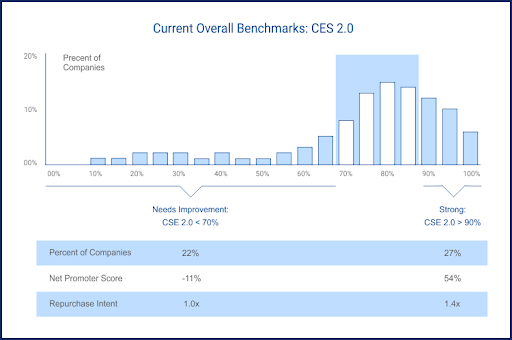
 We'd love your feedback!
We'd love your feedback!
 Thanks for your feedback!
Thanks for your feedback!





